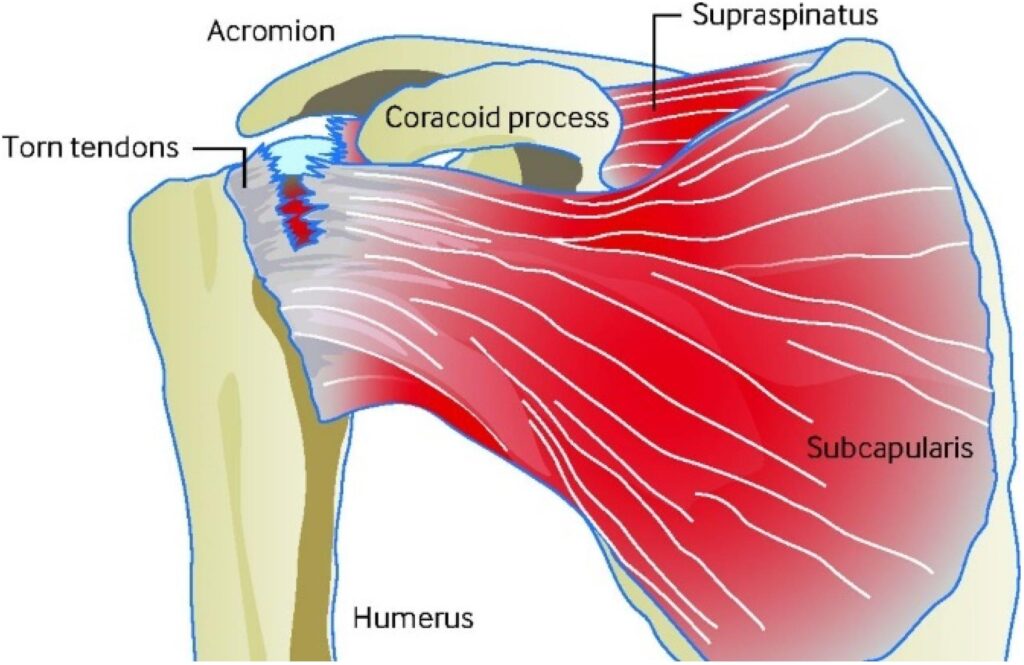The rotator cuff is a group of muscles and tendons that surround the shoulder joint, providing stability and enabling a wide range of motion. A rotator cuff tear (RCT) is a common injury that can cause significant pain and limit shoulder function. This article delves into the causes, symptoms, diagnosis, and treatment options for this condition, offering a comprehensive guide to understanding and managing it effectively.

Understanding the Rotator Cuff
The rotator cuff consists of four primary muscles and their associated tendons. These include the supraspinatus, infraspinatus, teres minor, and subscapularis. Together, they form a cuff-like structure that stabilizes the shoulder joint and allows for smooth movement. When one or more of these tendons become torn, it results in a rotator cuff tear.
Types of Rotator Cuff Tears
- Partial Tear: Also known as an incomplete tear, this type involves damage to the tendon without a complete separation.
- Full-Thickness Tear: This type occurs when the tendon is completely torn, creating a hole through the tendon.
Causes of Rotator Cuff Tears
Rotator cuff tears can result from a variety of factors, often categorized as either acute or degenerative.
Acute Causes
Acute injuries typically occur due to sudden trauma or overuse. Common scenarios include:
- Falling directly onto an outstretched arm
- Lifting something heavy with improper form
- A sudden jerking motion of the shoulder during physical activity
Degenerative Causes
Degenerative tears develop gradually over time due to wear and tear. Factors contributing to degeneration include:
- Repetitive overhead motions, such as those performed by painters, carpenters, or athletes
- Natural aging, which weakens the tendons and reduces blood supply to the area
- Bone spurs, which are bony growths that can rub against the tendons and cause damage
Symptoms of Rotator Cuff Tears
Recognizing the symptoms of a rotator cuff tear is crucial for timely diagnosis and treatment. Common signs include:
- Pain, especially at night or when lying on the affected shoulder
- Weakness in the shoulder, making it difficult to lift or rotate the arm
- A crackling sensation when moving the shoulder in certain positions
- Limited range of motion, particularly when trying to reach behind the back
In some cases, individuals may experience no pain despite having a significant tear, especially if the injury has developed gradually over time.
Diagnosing Rotator Cuff Tears
Accurate diagnosis is essential for determining the appropriate treatment plan. Healthcare providers use a combination of methods to identify a rotator cuff tear.
Physical Examination
A healthcare professional will assess the shoulder’s range of motion, strength, and areas of tenderness. Specific tests, such as the “drop arm test” or “empty can test,” may be performed to evaluate the integrity of the rotator cuff.
Imaging Tests
Imaging studies provide detailed insights into the extent and location of the tear.
- X-rays: While x-rays do not show soft tissues like tendons, they can help rule out other conditions such as arthritis or bone abnormalities.
- Magnetic Resonance Imaging (MRI): An MRI provides clear images of the soft tissues, allowing doctors to determine the size and severity of the tear.
- Ultrasound: This non-invasive test uses sound waves to create images of the tendons and muscles, helping to identify tears in real-time.
Treatment Options for Rotator Cuff Tears
Treatment for a rotator cuff tear depends on the severity of the injury, the patient’s age, activity level, and overall health. Options range from conservative measures to surgical intervention.
Non-Surgical Treatments
For many individuals, especially those with partial tears or mild symptoms, non-surgical treatments can be effective.
- Rest and Activity Modification: Avoiding activities that aggravate the shoulder can prevent further damage and promote healing.
- Physical Therapy: Strengthening exercises and stretches can improve flexibility and restore function to the shoulder.
- Medications: Over-the-counter pain relievers and anti-inflammatory drugs can help manage pain and swelling.
- Corticosteroid Injections: These injections can reduce inflammation and provide temporary relief, though they should be used sparingly to avoid weakening the tendon.
Surgical Treatments
Surgery may be recommended for individuals with severe tears, significant weakness, or those who do not respond to non-surgical treatments.
- Arthroscopic Repair: This minimally invasive procedure involves inserting a small camera and instruments through tiny incisions to repair the torn tendon.
- Open Repair: For larger or more complex tears, an open surgical approach may be necessary to access and repair the damaged tissue.
- Tendon Transfer: In cases where the tendon is too damaged to repair, a nearby tendon may be transferred to restore function.
- Shoulder Replacement: For advanced cases involving arthritis or extensive damage, a reverse shoulder replacement may be considered.
Recovery After Surgery
Post-surgical recovery typically involves a period of immobilization followed by physical therapy. Full recovery can take several months, and adherence to rehabilitation protocols is critical for optimal outcomes.
Preventing Rotator Cuff Tears
While not all rotator cuff tears can be prevented, certain measures can reduce the risk of injury:
- Maintain good posture to reduce strain on the shoulder joint
- Engage in regular shoulder-strengthening exercises
- Use proper techniques when lifting heavy objects
- Avoid repetitive overhead activities or take frequent breaks
Importance of Early Intervention
Addressing symptoms early can prevent further damage and improve the chances of successful treatment. Ignoring persistent shoulder pain or weakness may lead to more severe complications, including permanent loss of function.
Living with a Rotator Cuff Tear
For individuals managing a rotator cuff tear, lifestyle adjustments and ongoing care are essential. Regular follow-ups with a healthcare provider, adherence to prescribed therapies, and maintaining a healthy lifestyle can help minimize discomfort and maximize quality of life.





